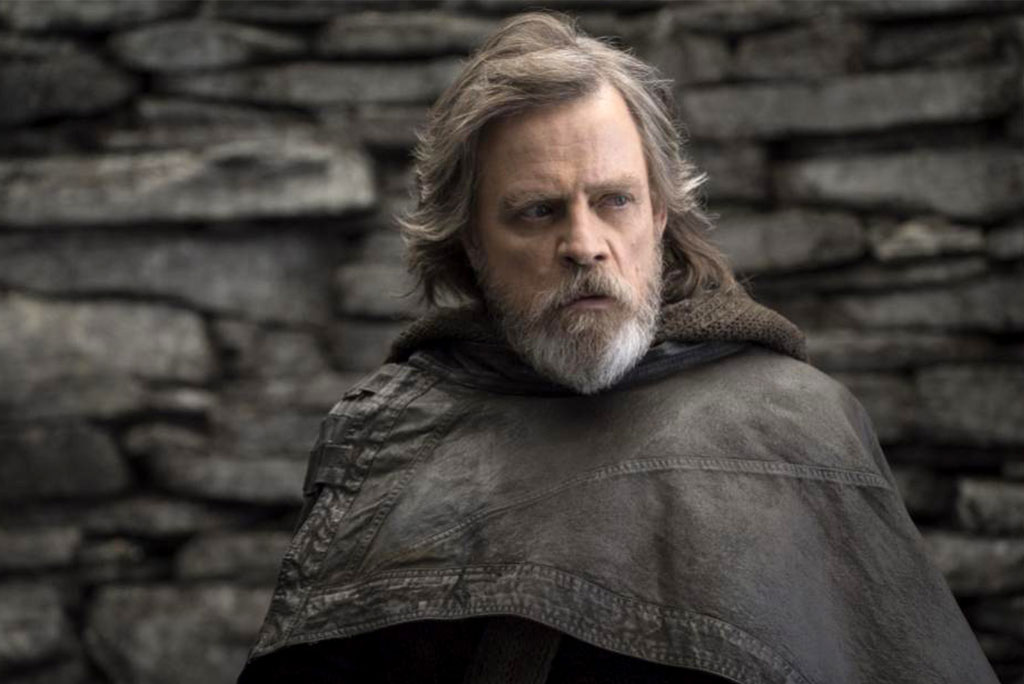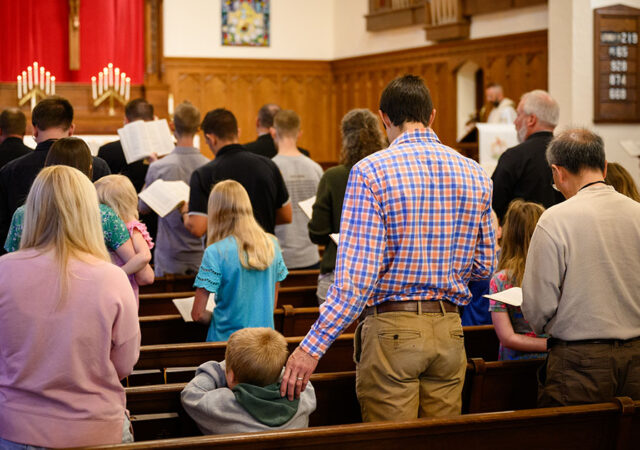
(Rated: PG [Canada] and PG-13 [MPAA] for sequences of sci-fi action and violence; directed Rian Johnson; stars Mark Hamill, Carrie Fisher, Adam Driver, Daisy Ridley, John Boyega, Oscar Isaac, Andy Serkis, Lupita Nyong’o, Domhnall Gleeson, Anthony Daniels, Gwendoline Christie, Kelly Marie Tran, Laura Dern, Benicio Del Toro, Frank Oz and Billie Lourd; run time: 152 min.)
In a galaxy too close to home …
By Ted Giese
In “Star Wars: Episode VIII — The Last Jedi” (2017), Resistance warrior Rey (Daisy Ridley) continues her mission to convince the Jedi Master Luke Skywalker (Mark Hamill) to return from his self-imposed exile to assist the Resistance in its fight against Supreme Leader Snoke (Andy Serkis), his apprentice Kylo Ren (Adam Driver), General Hux (Domhnall Gleeson) and the First Order.
Despite suffering great losses, Luke’s sister, Princess Leia Organa (Carrie Fisher), leads the Resistance’s evacuation and escape from its now-exposed secret base. With the First Order hot on their heels, a covert plot is hatched to help the Resistance slip through the fingers of its pursuers.
In the face of waning hope, the two forces are set against each other.
One desires the death of the past, seeing it as the only way forward; the other views a future won not by fighting what is hated, but by saving what is loved.
In the balance is the question, “Which side will have the spark that will light the fire for the future?” And viewers are left to ask, “What is the hope driving the characters in this saga?”
As Luke Skywalker says in the film’s trailer, “This is not going to go the way you think!”
And maybe that’s a good thing.
Comparisons to previous films
Some complained that “Star Wars: The Force Awakens” (2015) by J.J. Abrams was too much like “Star Wars: A New Hope” (1977) — that it was derivative, copying too much of what came before, and lacking in originality.
While “The Last Jedi” includes numerous call-backs and references to previous Star Wars films — and may be tonally similar to “Star Wars: The Empire Strikes Back” (1980) — it is still its own film.
The originality some hardcore Star Wars fans desired from this new film may end up being a point of criticism as the same fans dissect writer-director Rian Johnson’s “The Last Jedi.”
Conflict drives drama
By setting characters against each other, breaking trust with betrayals, including an unexpected (or if expected, unwanted) death into the unfolding story, drama emerges.
While some of that is present in “The Last Jedi,” the drama is not driven by open conflict but rather by frustration, or situational conflict.
Most character arcs and storylines converging in the film’s third act are driven by a series of frustrations and roadblocks. Things simply don’t go the way characters expect.
For example, Rey expects to collect quickly the legendary Jedi Master Luke Skywalker and return to the fight. When that doesn’t work, she assumes he will teach her the ways of the Force, but no, that doesn’t happen.
In the film’s trailer, Skywalker observes, “I only know one truth: It’s time for the Jedi to end,” and yet this doesn’t go the way he expects either.
In any film, it’s not unusual to find a villain’s plans frustrated. But it’s more unusual to find almost every effort of the heroes — practically all the plans of the good guys — frustrated and stymied.
Yes, heroes are often provided hurdles and setbacks to overcome, but in “The Last Jedi” they face true frustrations and real failures.
What’s behind these disappointments?
More than in any other Star Wars film, the idea of “balance in the Force” is present: that the Force — an energy field created by all living things surrounding and penetrating everything and binding the galaxy together — is seeking a balance between the light side and the dark side, and that a balanced universe is one of stasis, or a frustratingly sublime stalemate.
In such a system, one can fight balance, but it is futile. Eventually, the Force will get what it wants. As a result, in “The Last Jedi” the light and dark sides of the Force seem closer than ever before, and the closer they become, the more they start looking the same.
Skywalker’s failed student Kylo Ren’s conflicted heart and Rey’s zeal to “not fail” Skywalker come across as fluid expressions of the same thing. And amid all this emerges a great emphasis on feelings.
This direction allows Rian Johnson to dive more deeply into what the Force is and what it is not; who it belongs to and who it doesn’t belong to.
In a typical postmodern take on spirituality — and for the first time in any Star Wars film — the Jedi possess ancient sacred texts, only to have their importance downgraded along with the importance of the whole religion and the Jedi order itself.
And while the Force’s omnipresence and agency is explained in a way that starts to border on St. Paul’s description of God as being — “One God and Father of all, who is over all and through all and in all” (Eph. 4:6) — the Force is presented as not belonging to the Jedi or Sith religions, and by extension, the religions of the Jedi or the Sith don’t belong to the Force.
This frees Rey and Kylo Ren to make it up as they go along — to be spiritual, but not religious.
Individuals who ought to be their “heroes in their faith” permissively let them abandon what had been handed down for centuries. This makes “The Last Jedi” a film of its time.
What it gives with one hand, it takes back with the other, and then sometimes gives back again, making its religious landscape more conflicted and tortured than other Star Wars films.
Again, the theme of frustration emerges. For many fans hoping for answers, they may need to realize that “these are not the [answers] they’re looking for” and instead of dwelling on that and trying to resolve their frustration, they’ll simply need to “move along.”
For Christians, it’s best to remember that Star Wars in general, and this film in particular, act as a mirror reflecting the spiritual and religious ideas and attitudes of our time.
The film’s philosophical focus is eastward; it has more in common with the metaphysics of Taoism than with Christianity. Fans have known this for years, but in “The Last Jedi” Johnson seems to double down on this connection.
On the sacred Jedi planet Ahch-To (shot on the real-world island of Skellig Michael, off Ireland’s southwest coast), the production team even included a kind of yin-yang symbol (taijitu) in a shallow pool in a cave. This highlights the idea of the Force’s light side/dark side balance.
Viewers seeking a concrete systematic presentation of what is going on when it comes to the Force will be disappointed — and maybe that’s good, since Star Wars is fictional and the whole Force thing is made up, held together with spit and baling wire, ripped off from actual real-world religions.
It should go without saying, but bears repeating, the Force — however fun, interesting and cool on the screen — is not real, and as such is not a legitimate basis for a true, lasting, eternal faith.
The Force and the Jedi, even the evil Sith, tend to work better in the context of the Star Wars story when they are imbued with mystery. In the past, cracking open the mystery box and dumping out the contents hasn’t served the overall Star Wars story well. This is true in the present offering.
Balance is not the answer for Christians
One last theological consideration: Before the prequels (Episodes I, II and III), the original Episodes IV, V and VI presented a more clear-cut heroic tale of good triumphing over evil, operating as a kind of galactic David-and-Goliath story with a family-drama twist.
With the emphasis shifting to this idea of balance in the Force, it’s good for Christians to remember that by comparison, Christianity is not about finding or maintaining a balance between good and evil.
God is not equal parts good and evil. God doesn’t use death dispassionately to help create a balance with life.
For Christians, The End will not be one of balance, because on The Last Day, God “will wipe away every tear from their eyes, and death shall be no more, neither shall there be mourning, nor crying, nor pain anymore, for the former things have passed away” (Rev. 21:4).
At the cross of Good Friday, Jesus’ death didn’t bring balance but rather defeat to sin, death, the devil and hell. In fact, Jesus is not a balance of light and dark — He’s “the light [which] shines in the darkness and the darkness has not overcome it” (John 1:5).
As a result, Christianity is not a religion teaching balance between the light side and the dark side in the universe, but the victory of good over evil.
In many ways, with its focus on frustration and failure, the film sets an opportunity for character growth. As St. Paul says, “Suffering produces endurance, and endurance produces character, and character produces hope” (Rom. 5:3–4).
The question is whether the frustrated characters of the Resistance and the First Order, in the depths of their failures, will end up rejoicing in their sufferings and failures, and thereby, learn from them. Will these character–building experiences produce a new hope in them?
The answers will be out of Rian Johnson’s hands, as J.J. Abrams takes over the directing duties for Episode IX.
Many believe that “The Empire Strikes Back” (1980) remains the best Star Wars film. For the time, it was certainly a film that took some big risks.
“The Last Jedi” also takes some big risks. Will they pay off?
Johnson has made a perfectly good film, better than some other Star Wars films. However, it isn’t a perfect film and has some major plot holes typical of every Star Wars film.
Some people will love it as they love all things Star Wars. Others will not, mainly because it didn’t go the way they thought it should, leaving them frustrated.
It’s interesting that such feelings of frustration may put them in balance with the very themes expressed in “The Last Jedi”! Such viewers may end up looking around at everything that appears and sounds like Star Wars only to say, “I don’t know … I have a bad feeling about this.”
The two questions raised in the film could be asked of the Star Wars franchise in general and of “The Last Jedi,” in particular: Does the past have to die to move forward? Or is the future won not by fighting what is hated, but by saving what is loved?
Watch the trailerThe Rev. Ted Giese (pastorted@sasktel.net) is lead pastor of Mount Olive Lutheran Church, Regina, Saskatchewan, Canada; a contributor to the Canadian Lutheran, Reporter Online and KFUO.org; and movie reviewer for the “Issues, Etc.” radio program. Follow Pastor Giese on Twitter @RevTedGiese.
Posted Dec. 26, 2017





Another review of stellar quality; thank you! Now to see the movie.
Actually, Rey kept the Jedi texts, stowing them on the Millennium Falcon where we the audience see them at the end – while Luke had to let go of his fear of the past by believing the books were destroyed, Rey gets to learn from their wisdom and keep the Jedi religion alive. It’s the farthest thing possible from downgrading religion and making it up as they go along.
Hi James! I do try to avoid some spoilers if possible. I did notice that they were tucked away on the Millennium Falcon at the end of the film that’s why I said, “What it [the film] gives with one hand it takes back with the other and then sometimes gives back again making its religious landscape more conflicted and tortured than other Star Wars film.” Some people may have missed that quick little moment when Finn opens the drawer and the books are there tucked away for safe keeping … maybe Rey will, you know, turn those pages. Here’s hoping. Thanks for reading the review!
Here’s an interesting juxtaposition!
As Yoda says, “Fear is the path to the dark side…fear leads to anger…anger leads to hate…hate leads to suffering.” The Phantom Menace
As St. Paul says, “Suffering produces endurance, and endurance produces character, and character produces hope” Romans. 5:3–4